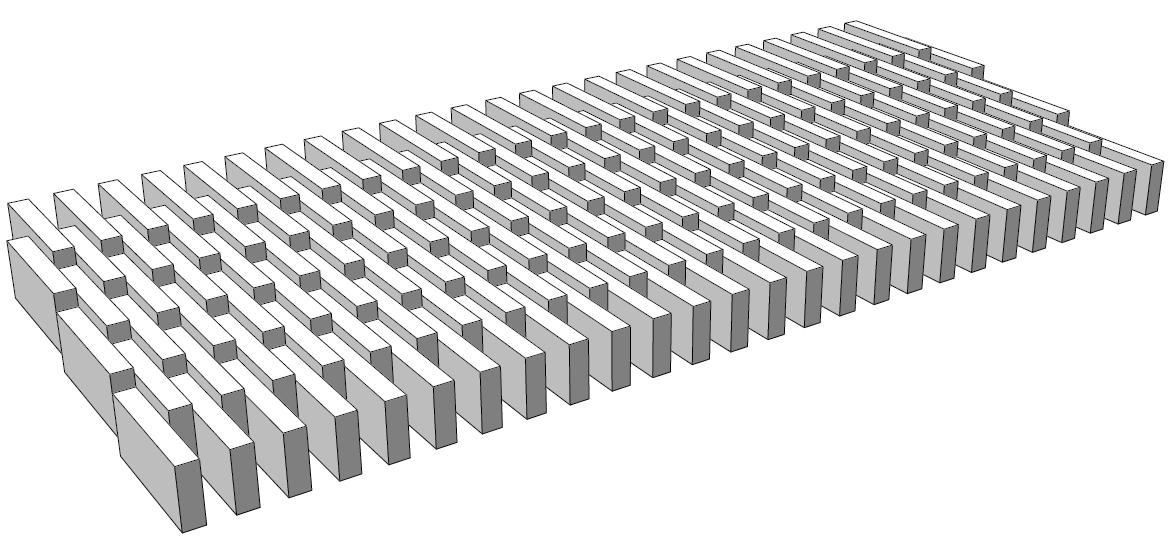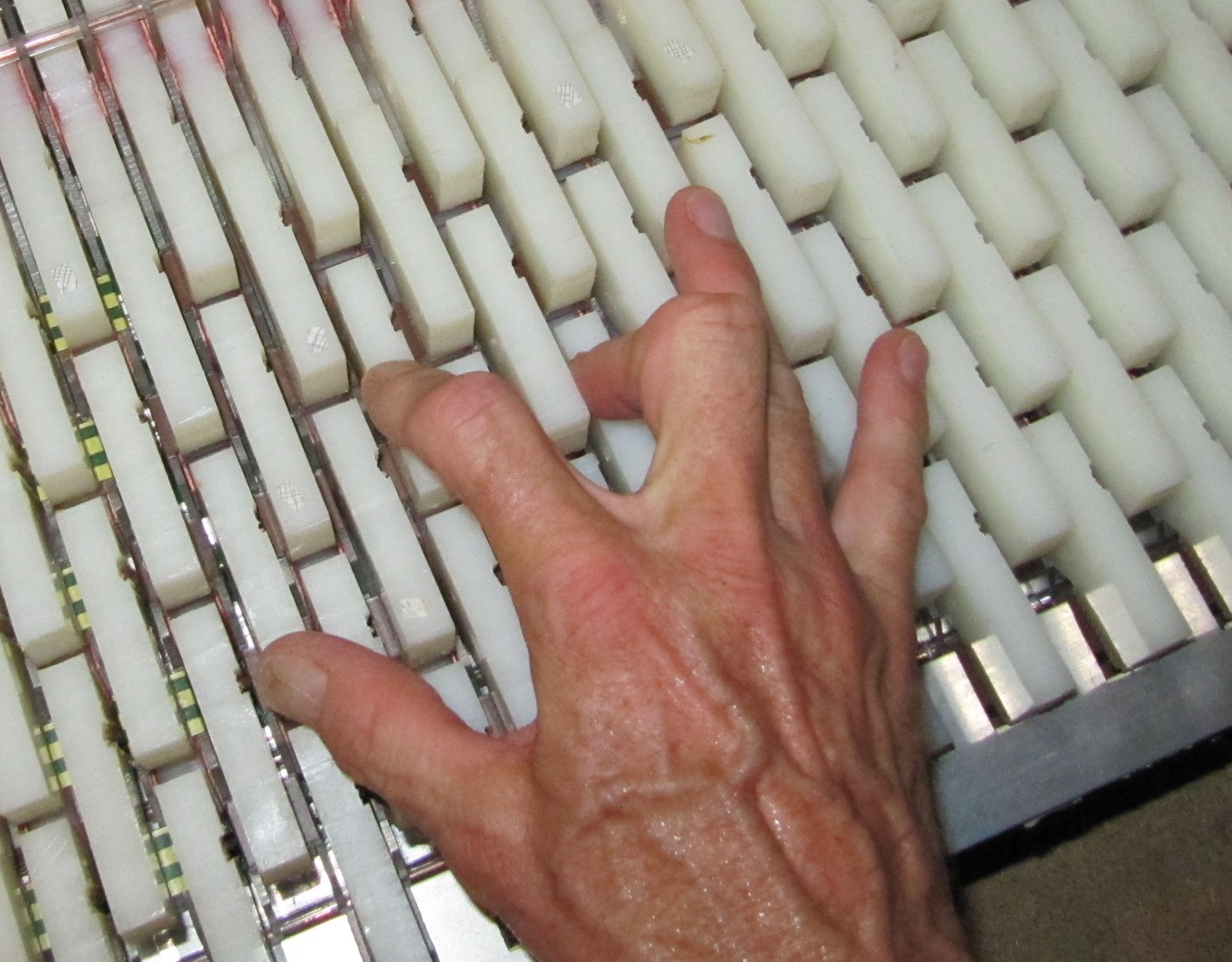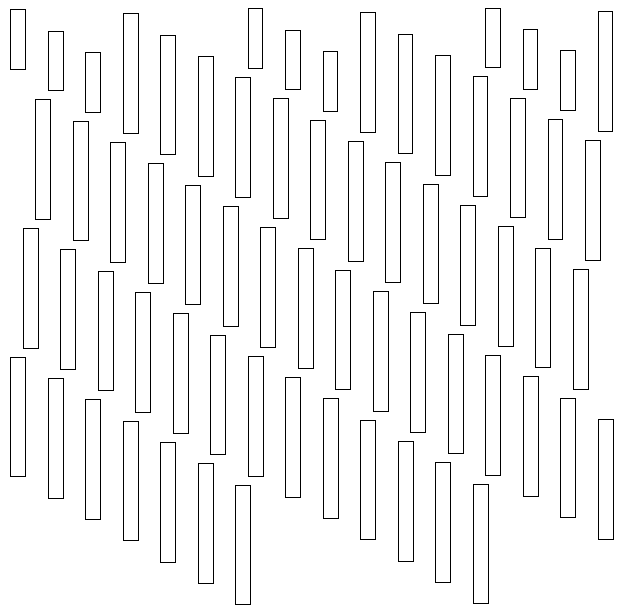
After reading this, you may want to know which buttons to push when you read Bach's notes: read. Or you may wonder how easy it is to to play the keyboard. Watch the mistery organist playing BWV 534 Prelude and BWV 547.

The idea for the keyboard was borrowed from how a concert harp works: with only 7 strings per octave, it can play 21 different
tones per octave. Ordered in pure fifths, the strings are:
F, C, G, D, A, E, B.
A harp player uses pedals to change the actual selection of tones available on the 7 strings per octave. In the neutral position, these tones are F, C, G, D, A, E, B, so s/he can play in C major and A minor. By pushing a certain pedal, the F to the left in this series is removed and to the right F♯ is added (practically: all F strings are shortened a semitone to F♯) and s/he can play in G major and E minor. A different pedal can be used to remove the B on the right and add a B♭ to the left, etc.
This way (i.e. using the pedals), the available tones are:
F♭, C♭, G♭, D♭, A♭, E♭, B♭,
F, C, G, D, A, E, B,
F♯, C♯, G♯, D♯, A♯, E♯, B♯.
This same idea is used on the just intonation keyboard. At any one moment 30 different tones per octave are available through as many buttons per octave. For instance:
| E♯ | B♯ | F♯♯ | C♯♯ | G♯♯ |
| C♯ | G♯ | D♯ | A♯ | E♯ |
| A | E | B | F♯ | C♯ |
| F | C | G | D | A |
| D♭ | A♭ | E♭ | B♭ | F |
| B♭♭ | F♭ | C♭ | G♭ | D♭ |
This is a section of the matrix we saw earlier. Let us first order the tone names in each row for ascending pitch from left to right:
| C♯♯ | E♯ | F♯♯ | G♯♯ | B♯ |
| C♯ | D♯ | E♯ | G♯ | A♯ |
| C♯ | E | F♯ | A | B |
| C | D | F | G | A |
| D♭ | E♭ | F | A♭ | B♭ |
| C♭ | D♭ | F♭ | G♭ | B♭♭ |
Next step is shifting even rows to the left and odd rows to the right:
| C♯♯ | E♯ | F♯♯ | G♯♯ | B♯ | ||||||
| C♯ | D♯ | E♯ | G♯ | A♯ | ||||||
| C♯ | E | F♯ | A | B | ||||||
| C | D | F | G | A | ||||||
| D♭ | E♭ | F | A♭ | B♭ | ||||||
| C♭ | D♭ | F♭ | G♭ | B♭♭ | ||||||
Then we rotate each rectangle by 90 degrees and we have one octave of the just intonation keyboard:
The C major scale has a grey background in this diagram to highlight its fingering. The fingering is quite like that of the A major scale on an ordinary keyboard. With this particular section of the matrix, one can play the just intonation keyboard in the following major keys (all with the same fingering): F♭, C♭, A♭, E♭, C, G, E, B, G♯, D♯ and in as many minor keys.
If we then put a total of five octaves side by side, we have a complete organ keyboard as shown at the top of this page.
We have to make one specific remark concerning playing syntonic commas. If we want to play that as an ordinary tone repetition (albeit with a slightly different pitch), we first release the first key and only then press the other. But sometimes it is more appropriate to play the syntonic comma with a quick glissando from the first pitch to the second. In that case we would play it in a legatissimo manner: we press the second key before releasing the first one. Obviously, the electronics controlling the keyboard should be equipped for this special treatment of syntonic commas.

The chord C-E-G-A♯-C on a prototype keyboard.
Obviously, during playing, the organist must do what a harpist does: from time to time change the selection of pitches available on the keyboard. See Pitch Selection Control below for that.
You may wonder why a keyboard has six rows of keys and not five or seven. When we let the optimization algorithm run with an unlimited number of matrix rows at its disposal, the pieces on this website never claim more than six matrix rows, as you can check for each sound file. As each matrix row is represented by one keyboard row, six rows of keys should do for most music, if not all.
THIS SECTION IS OBSOLETE. A BETTER DESIGN IS COMING UP.
A preview of the pedal keyboard (two and a half octaves):

Most ordinary organs have a pedal keyboard, usually about two and a half octaves wide. We saw that a just intonation manual keyboard has six rows of keys. For a pedal keyboard that number of rows is out of the question, as we require keys to be the length of a shoe, so the organist can heel-toe-heel-toe from left to right over the keyboard. At the time of writing (November 2018) a definite solution is not available yet, but a candidate is. At one particular moment, its keys could represent the 19 grey background pitches in the matrix that we know:
| E♯ | B♯ | F♯♯ | C♯♯ | G♯♯ |
| C♯ | G♯ | D♯ | A♯ | E♯ |
| A | E | B | F♯ | C♯ |
| F | C | G | D | A |
| D♭ | A♭ | E♭ | B♭ | F |
| B♭♭ | F♭ | C♭ | G♭ | D♭ |
The 19 grey cells ordered by pitch starting at C:
| C | C♯ | D♭ | D | D♯ | E♭ | E | F♭ | F | F♯ | G♭ | G | G♯ | A♭ | A | A♯ | B♭ | B | C♭ |
We divide these evenly over three rows:
| D♭ | E♭ | F | G | A | B | |||||||||||||
| C♯ | D♯ | F♭ | G♭ | A♭ | B♭ | |||||||||||||
| C | D | E | F♯ | G♯ | A♯ | C♭ |
Next, we squeeze these together like an accordion bellow and we get the idea of one octave of the pedal keyboard:
| D ♭ |
E ♭ |
F | G | A | B | |||||||||||||||
| C ♯ |
D ♯ |
F ♭ |
G ♭ |
A ♭ |
B ♭ |
|||||||||||||||
| C | D | E | F ♯ |
G ♯ |
A ♯ |
C ♭ |
||||||||||||||
To complete the keyboard, we put two and a half octaves side by side and repeat the bottom row at the top:
| C | D | E | F ♯ |
G ♯ |
A ♯ |
C ♭ |
D ♭ |
E ♭ |
F | G | A | B | C ♯ |
D ♯ |
F ♭ |
||||||||||||||||||||||||||||||||||
| D ♭ |
E ♭ |
F | G | A | B | C ♯ |
D ♯ |
F ♭ |
G ♭ |
A ♭ |
B ♭ |
C | D | E | F ♯ |
||||||||||||||||||||||||||||||||||
| C ♯ |
D ♯ |
F ♭ |
G ♭ |
A ♭ |
B ♭ |
C | D | E | F ♯ |
G ♯ |
A ♯ |
C ♭ |
D ♭ |
E ♭ |
F | ||||||||||||||||||||||||||||||||||
| C | D | E | F ♯ |
G ♯ |
A ♯ |
C ♭ |
D ♭ |
E ♭ |
F | G | A | B | C ♯ |
D ♯ |
F ♭ |
||||||||||||||||||||||||||||||||||
The extra row of short keys at the top has been added so chromatic passages can be played heel-toe with one foot on all tones in all octaves. With the example selection of 19 matrix cells, one can play in the major keys of B, G, E♭ and C♭ and in the minor keys of G♯, E, C and A♭.
This pedal keyboard layout has some drawbacks:

Until someone comes up with a better pedal keyboard layout (let me know), we have the choice between this far-from-ideal pedal keyboard or no pedal keyboard at all. I think this observation should make it easier to overcome the objections.
If we do that, we only have to find a way to control the exact selection of 19 matrix cells available at each moment. Imagine the example matrix selection has to move one column to the left. Then the rightmost five grey background pitches (A♯, C♯, A, F and D♭) are replaced by five of the pitches in the white background column to the left (namely C♯, A, F, D♭ and B♭♭). Where the tone names stay the same (C♯, A, F, D♭) the pitches change by a syntonic comma. The A♯ is replaced by B♭♭.
The selection of 19 tones may also have to shift up or down within the six rows of the matrix. We distinguish four different vertical subsections of 19 tones, grey below:
The current idea (November 2018) is to have the electronics of the manual keyboards track the average coordinates of the matrix cells the organist is using at any time. That results in an average point virtually hovering over the matrix. The electronics should then make sure that within the 6 x 5 section for the manual keyboard the set of 19 matrix cells for the pedal keyboard stays centered around this average matrix point. This will work fine most of the time. But in very rare occasions, a required pedal tone pitch may be outside the automatically predicted set of 19 matrix cells. For that, see Pitch Selection Control below.
If you are familiar with different tunings, you may know about 19 tone equal temperament, where an octave is divided in 19 equal steps. Music in that tuning could be played on this same pedal keyboard. In fact, a keyboard for this tuning inspired me to investigate its possibilities for the just intonation organ. By the way, in the 19 tone equal temperament the tone name change mentioned above (A♯ to B♭♭) is a so called enharmonic change: the tone name changes, but not the pitch. Obviously, in just intonation the pitch does change, by an interval with a pitch ratio of 16384 / 16875 or 51.12 cents down. If you must know.
Let us take the example of a 6 x 5 matrix selection for the manual keyboard as a starting point:
| E♯ | B♯ | F♯♯ | C♯♯ | G♯♯ |
| C♯ | G♯ | D♯ | A♯ | E♯ |
| A | E | B | F♯ | C♯ |
| F | C | G | D | A |
| D♭ | A♭ | E♭ | B♭ | F |
| B♭♭ | F♭ | C♭ | G♭ | D♭ |
Then by an action equivalent to pushing a pedal on a concert harp, the left hand column in this matrix section is removed and to the right a new column is added:
| B♯ | F♯♯ | C♯♯ | G♯♯ | D♯♯ |
| G♯ | D♯ | A♯ | E♯ | B♯ |
| E | B | F♯ | C♯ | G♯ |
| C | G | D | A | E |
| A♭ | E♭ | B♭ | F | C |
| F♭ | C♭ | G♭ | D♭ | A♭ |
And vice versa for removing a column on the right side and adding one to the left. By one such change, 24 buttons per octave retain their tone name and pitch, the other six buttons change. In the example above, each change is a semitone down, following the two grey background columns: E♯ becomes D♯♯, C♯ becomes B♯ etc.
As an organist has a pedal keyboard to be played, s/he cannot do this shifting by pushing pedals as a harpist does. The current idea (November 2018) is to do what Bob Dylan did when he played a guitar and a harmonica at the same time. Pictures of that are easy to find on the internet. Instead of a harmonica, we would have a device with two holes that the organist would be blowing in the wind:
One could imagine more uses for such a blowing device, for instance turning pages, activating stops or checking one's alcohol percentage. For now, let us not overload the idea.
Next: Automatically annotating sheet music